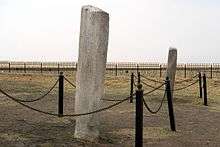Bain Tsokto inscriptions

Bain Tsokto inscriptions are Turkic inscriptions of the 8th century in Mongolia.
Geography
The inscriptions are in Tuul River valley at 47°42′N 107°28′E / 47.700°N 107.467°E (southeast of Ulan Bator and Nalaikh).[1] Usually they are considered as a part of Orkhon inscriptions (Khöshöö Tsaidam inscriptions). But actually Orkhon inscriptions are located about 360 kilometres (220 mi) to the west of Bain Tsokto.
History

Bain Tsokto inscriptions are about Tonyukuk the counselor of four Turkic khagans . (Ilterish Khagan, Kapaghan Khagan, Inel Khagan and Bilge Khagan). He died in the 720s. Unlike the two other Orkhon inscriptions which were erected after the hero had died, Bain Tsokto inscriptions were erected by Tonyukuk himself in 716 (?).[2] (His deeds after 716 had not been narrated.) The narrator is Tonyukuk. The inscriptions were inscribed on two steles .The writing is from top to bottom and the alphabet is Old Turkic alphabet.
Summary of the text[3][4]
1st stele (35 lines)
- West side:The revolt of Turks against Tang China in 681. (after Chine subjugated Turks in 630)
- South side: War against Oghuz Turks
- East side:Capture of 23 cities and plan to counterattack against a possible alliance of the neighbors (China, Onoq and Yenisei Kirghiz)
- North side:Defeat of Yenisei Kirghiz (north) and campaign to Turgesh (west)
2nd stele (27 lines)
- West side: Battle of Bolchu (711) against Turgesh and annexation of Onoq territory (roughly present Turkestan)
- South side:Annexation of Temir Kapig, Ilterish Qaghan’s 7 campaigns to Khitan people (east), 17 campaigns to China (south), 5 campaigns to Oghuz Turks
- East side: (Tonyukuk praises himself on his valuable assistance to khagans and adds that he gets old)
- North side:(Epilogue) After the victories, Turks and Sir (people) live happily.
See also
References
- ↑ Don Croner's World Wide wanders
- ↑ Türkçe bilgi (Turkish)
- ↑ University of London Orkhon Inscriptions
- ↑ Muharrem Ergin:Orhun Abideleri, Boğaziçi Yayınları,İstanbul, 1980, pp.54-61